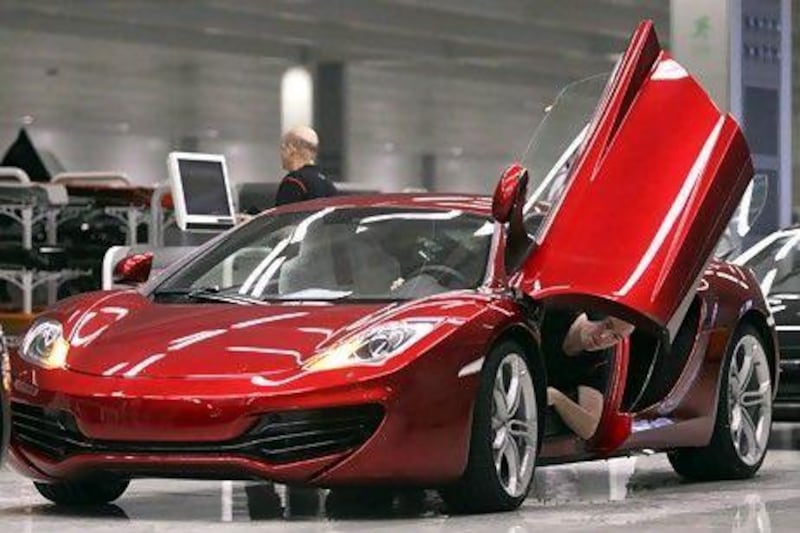Every day, like clockwork, technicians hand-building McLaren's road-going supercars down tools and walk over to the company's Formula One factory.
The appointment is not for a daily motivational team talk or a meeting. It is just lunch.
But the set-up is designed to achieve more than just saving catering costs.
"If we can get the aerodynamics experts in the road car and the Formula One car sitting together informally, ideas come out of that more often than if you say, 'Let's have a meeting at 3pm to discuss what the Formula One team can bring to the road car,'" says Mark Harrison, the regional director of McLaren Middle East and Africa.
McLaren was an F1 team first, so its cars, such as the £800,000 McLaren P1, the company's all-new "ultimate supercar" that was revealed in September, are more like those lining up at the Yas race circuit today than most on the road.
For a start they are all made of carbon fibre, like Formula One cars. And in one of its models, the MP4-12C, the steering wheel is similar to that used by the McLaren Mercedes F1 driver Lewis Hamilton.
But how much of a Formula One car actually ends up in the vehicles we drive to work?
"If you ask are there absolutely specific components, could you take a part of a Formula One car and put it on a road car? The answer is no," says Nick Fry, the chief executive of the Mercedes AMG Petronas Formula One team.
Each component in an F1 car is designed for a purpose. And the parts used in cars on the track are not designed to last long.
But much of the technology used in road cars, from seat belts to buttons on steering wheels and paddle-shift gears, started in racing.
"I got a cynical link from someone from our Hong Kong office saying, 'Look at this guy, some wannabe expert on a blog saying there is absolutely zero transfer from F1 to a road car'," says Andreas Sigl, the global director for Infiniti Formula One.
Infiniti, the luxury arm of Nissan, manufactures luxury, high-performance road cars and works in partnership with the championship-winning Red Bull Racing team.
"I think people look at it in a very superficial way by saying this switch or this button or this thing is exactly like an F1 car. But if you look at it in terms of people, process and technology it can, even in today's world, be a two-way street," Mr Sigl adds.
An electronics engineer from Infiniti joined Red Bull in September. And the two companies have other research and development tie-ups.
From a process point of view, Infiniti can learn a lot from Red Bull.
"Once we build a car, we build it and stamp it for the next five years and we try to do it perfectly with no mistakes. [F1 teams] basically build a prototype every week and every other week," says Mr Sigl. "In terms of time to market they can help us move faster."
Car manufacturers such as Infiniti have another shared interest with Formula One teams.
"The latest innovation in Formula One is Kers, which is kinetic energy recovery system," says Heikki Kovalainen, a driver with the Caterham F1 team, which is working with GE on aerodynamics, one of the most important aspects of the car. "Basically, when we are braking, the brakes are generating a lot of heat that is being collected so it can be used as a [power] boost."
It is the same type of technology used in hybrid cars, so both road car and F1 manufacturers have an interest in developing it.
"One of the things we struggle with a little bit in Formula One is to remain relevant. We make cars go very fast round corners but an internal combustion engine rotating at 21,000 rpm, which is where we were a few years ago, isn't really relevant [to production cars]," says Mr Fry.
"It's got no known spin-off that we could find and so we went down the road of energy recovery systems," he adds.
Experts say the next technology to transfer to road cars could be carbon fibre. Benefits include lighter cars and a stronger chassis, which improves crash safety.
In 1995 it took McLaren 3,000 hours to make one carbon fibre chassis, by 2005 the company had cut the process down to 300 hours, and now it takes about three hours.
"Once the bigger car companies get into that, you could get down to one hour and then half an hour," says Mr Harrison.
So what is stopping them?
"Partly it is that there isn't a huge amount of carbon fibre around. Most carbon fibre goes into aircraft. So while there are a few cars using carbon fibre, all the demand goes to the aerospace industry," he says.
The key challenge for the car industry is whether it has enough clout to get carbon fibre at a price that allows it to innovate, says Mr Harrison, as it needs to be ordered in bulk to drive the cost down.
But no amount of technology transfer from F1 will make a road car exactly like those that race on the track.
"It's like flying to the moon," says Vitaly Petrov, Kovalainen's teammate at Caterham.
"Not a lot of people can fly to the moon and not so many people can drive F1 cars."






